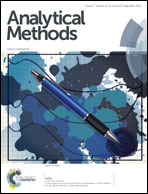Novel artificial antigen synthesis for antibody production and development of an indirect competitive ELISA of cyanocobalamin
Abstract
In the current work, cyanocobalamin is coupled to Bovine Serum Albumin (BSA) and ovalbumin (OVA) by a CDI method to produce artificial antigens. Then a monoclonal antibody (MAB) against cyanocobalamin was acquired. In comparison with other reported antibodies, the MAB showed good specificity toward cyanocobalamin. Cross reactivity was found to be less than 0.01% with other compounds of vitamin B, except for three analogs of cobalamins which showed a cross reactivity from 0.27% to 2.31%. An indirect competitive enzyme-linked immunosorbent assay (ic-ELISA) for the detection of cyanocobalamin was developed based on the MAB. Under the optimum conditions, the limit of detection was 0.2 ng mL−1 with a linear working range of 2–100 ng mL−1 (R2 = 0.993). The spiked samples were detected with recovery ranging from 86.02–110.54%, and the coefficients of variation were from 2.62% to 13.7%. Six commercially available vitamin supplements were tested by the ELISA method, after purification with an immunoaffinity column, the samples were validated by HPLC with UV detection at 361 nm. The results obtained also showed good correlation between ELISA and HPLC (R2 = 0.998). Thus, the method proposed had been proved to be a trustworthy tool to quantify cyanocobalamin in vB12 tablet supplements.


 Please wait while we load your content...
Please wait while we load your content...